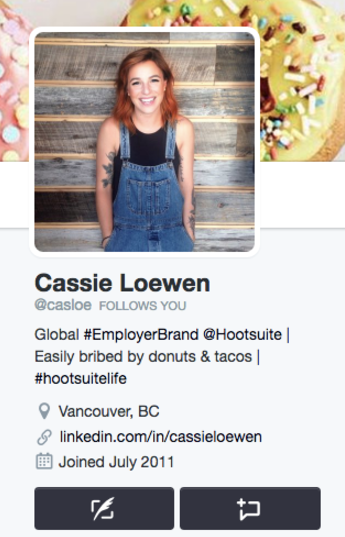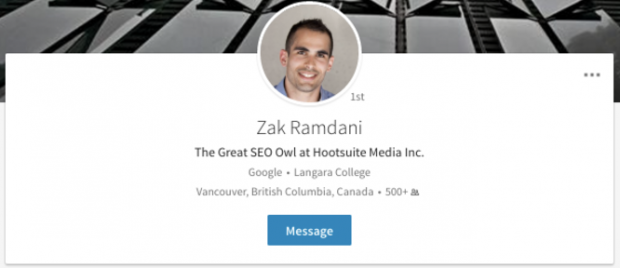The familiar sound of a Twitter notification echoes on my phone. I’ve received a direct message from another user.
“Thanks for the follow! Click this link to learn more about me,” the automated words populate on my screen. This is the written equivalent of a pre-recorded voicemail and they’re asking me to drive traffic back to their site.
Aren’t we past generic messages and overly self-promotional content?
A direct message (DM) is a private message sent to a user on social media. They’re often used for getting in touch with a prospect, contacting a hiring manager, or simply establishing a business connection. They show up in a user’s personal inbox—so shouldn’t they be personable?
At Hootsuite, our human resources and sales teams are constantly reaching out and being contacted over social media. We spoke to the experts—Cassie Loewen, our global employer brand specialist, and Mike DeCastro, an enterprise development representative—who gave us the 411 on sending professional DMs.
4 tips for sending the perfect social media DM
1. Reach people through various touch points
Recruiting expert Cassie Loewen has a theory about connecting with people on social media.
“It’s kind of like dating,” she says Explaining that it’s better to have built a rapport before asking someone on a date so that the interaction is as seamless as possible.
Thankfully, social media is designed for socializing—built on likes, shares, replies, and comments. It’s not strange to engage with the same user multiple times—and on different social media platforms—before reaching out to them directly.
Could you imagine doing that over email? It’s more acceptable to receive five retweets from the same user than it is to receive five emails.
When developing a strategy to get to know someone over social, try using a layering technique. Find the person you want to reach out to on different social networks and interact with them in different ways., You could share one of their LinkedIn articles and then give them a shoutout in one of your tweets.
Mike DeCastro, one of Hootsuite’s sales experts, likes to tweet at potential prospects on Fridays with a simple, “Have a good weekend!” He combines this with liking and commenting on a few of their social media posts. Only then does he follow-up with a request to connect.
The key is to reach that person at different touch points so that when you send a DM, it feels like a natural progression of your relationship.
2. Be strategic with your message
So you’ve commented on someone’s tweets and you’ve shared a couple of their articles on LinkedIn. Now you’re ready for the next step in your relationship—crafting that pivotal direct message. This is your shot at making a good first impression.
Tips for planning your attack:
- Make it short and sweet. People are busy and don’t have time to read a novel. Keep it simple and don’t overwhelm them with information.
- Be professional. Avoid spelling mistakes, skip the jargon, and don’t use internet slang. “Wassup? Hey how r u?” doesn’t exactly translate to “I’m a qualified professional.” Especially on a platform like LinkedIn, using too much slang or jargon won’t get your message the respect it deserves.
- Be clear. State why you’re reaching out and give them incentive to respond. If you’re contacting the hiring manager at your dream company, be clear that you’re hoping to land a position, explain why you’d be a great fit, and suggest a means of connecting offline.
- Don’t make them do extra work. You already want a reply, so think about what you’re asking on top of that. Do you want the person to comb through your resume and then to match you with available positions at their company? Asking for too much might turn the person off from responding to your DM.
- Include a CTA. Have a call-to-action that provides actionable next steps. Without a CTA, your DM might go unanswered. What are they supposed to do with the knowledge of your existence? Try, “Let me know if you’re interested.” Or if you want to get specific, “How about a call on Thursday at 3 p.m.?”
3. Know your audience
Loewen and DeCastro are both huge fans of personalized DMs. They demonstrate effort and care.
Getting to know your audience is necessary to separate yourself from the crowd. If you’re reaching out to a sales lead or an HR person, there are probably hundreds of other people doing the same.
How you can personalize your DM:
- Do your research. Take a least five minutes to scan the contact’s profile and gather information on them. Check out their bio, what kind of content they’re posting, and what might be top-of-mind for them at the moment. Is it their favorite sports team? A book they’ve been reading? Use that intel to add a personal spark to your message.
For example, one look at Loewen’s Twitter profile will let you know exactly what she’s interested in. (Hint: it’s donuts.)

- Tailor your message to their communication style. Do they use emoji? Do they share a lot of jokes? Do they refer to themselves as something other than their real name? Incorporate some of those details into your message.
For example, if you’re thinking about contacting Hootsuite’s SEO specialist—Zak Ramdani—you might want to refer to him as The Great SEO Owl instead.

- Avoid templates and automated messaging. “Once I notice a template, I immediately unfollow them,” DeCastro tells us. People want a well-thought-out message, not something generic. Nobody wants to talk to a robot and nobody wants to be subscribed to a bunch of broadcasted messages.
Sending out a professional DM is a give-and-take process. If you don’t put in the work to get to know them, why should they put in the work of replying?
4. Tailor your message to the platform
Each social media network caters to a specific kind of interaction and a different level of privacy. When connecting with someone you’ve never met before, be mindful of the nuances of the social network you’re using and the expectations for privacy on that platform.
Networking approaches best suited for each platform:
- Twitter. Best for casual interactions. It’s where you can do some mingling by liking and retweeting a few of their posts.
- LinkedIn. Best for professional interactions. LinkedIn is meant for business networking, so it’s also where you’ll find the most competition when trying to connect with someone directly.
- Instagram. Getting personal. People are posting pictures of their personal life, but might also be looking at branded content. Although Loewen prefers to have met someone in person before letting them follow her on Instagram, she also finds it great for sharing what #HootsuiteLife is all about.
- Facebook. For personal use. People use it to connect with family and friends, so it’s not the best place to reach out to a potential business contact. Keep in mind there’s also a chance that someone might not receive your DM, as Facebook files messages from outside your “Friends” list in in “Other” inbox.
- Snapchat. The most personal. Cassie says if she’s met someone in person a few times, exchanging Snapchat handles seems appropriate. If you’re trying to connect with a sales prospect or potential candidate, it’s can be a great way to showcase some of the behind-the-scenes of your brand.
Even though social media is a public space, it’s important to remember that everyone has their own personal boundaries. Some good rules of thumb are to avoid digging deep into someone’s social media activity and commenting on their personal lives.
Use Hootsuite to discover new leads, monitor real-time conversations, and manage DMs across all your networks in one place. Try it free.